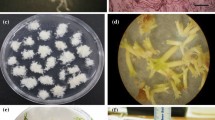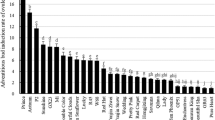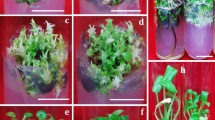Abstract
We report a method for regenerating somatic embryos from protoplasts derived from a cell suspension culture containing proliferating embryonal–suspensor masses (ESMs) of developing loblolly pine seeds. Uniform, highly viable and morphogenic protoplasts from embryonal cells contained a dense neocytoplasm as judged by strong acetocarmine staining. Culture qf protoplasts in a thin layer of agarose in a medium using high levels of myo–inositol contributed to the proliferation of colonies of proembryonal cells with large nuclei, which in turn yielded new ESMs. When protoplast–derived ESMs were placed on agar plates, somatic embryos were recovered within 8 to 10 weeks by somatic polyembryogenesis. After a total of 15 weeks an initial crop of over 100 somatic embryos could be regenerated by a conifer–type developmental plan from an initial population of 105 protoplasts.
This is a preview of subscription content, access via your institution
Access options
Subscribe to this journal
Receive 12 print issues and online access
$209.00 per year
only $17.42 per issue
Buy this article
- Purchase on Springer Link
- Instant access to full article PDF
Prices may be subject to local taxes which are calculated during checkout
Similar content being viewed by others
References
Gupta, P.K. and Durzan, D.J. 1987. Biotechnology of somatic polyembryogenesis and plantlet regeneration of loblolly pine. Bio/Technology 5: 147–151.
Kirby, E.G. and Cheng, T.Y. 1979. Colony formation from protoplasts derived from Douglas-fir cotyledons. Plant Sci. Lett. 14: 145–154.
David, A. and David, H. 1979. Isolation and callus formation from cotyledon protoplasts of pine (Pinus pinaster). Z. Pflanzenphysiol. 94: 173–177.
Hakman, I.C. and Von Arnold, S. 1983. Isolation and growth of protoplasts from cell suspensions of Pinus contorta. Plant Cell Reports 2: 92–94.
Patel, K.R., Shekhawat, R.S., Berlyn, A.P., Thorpe, T.A. 1984. Isolation and culture of protoplasts from Pinus coulteri. Plant Cell Tissue and Organ Culture 3: 85–90.
Teasdale, R.D. and Rugini, E. 1983. Preparation of viable protoplasts from cell suspension-cultured loblolly pine (Pinus taeda) cells and subsequent regeneration to callus. Plant Cell Tissue Organ Culture 2: 253–261.
Gupta, P.K. and Durzan, D.J. 1986. Isolation and cell regeneration of protoplasts from sugar pine (Pinus lambertiana). Plant Cell Reports 5: 346–348.
Steward, F.C. and Krikorian, A.D. 1979. Problems and potentialities of cultured plant cells in retrospect and prospect, p. 221–262. In: Plant Cell and Tissue Culture: Principles and Applications Sharp et al. (Eds.) Ohio State University Press, Columbus.
Vardi, A., Spiegel-Roy, P. and Galun, E. 1983. Protoplast isolation, plant regeneration and somatic hybridization in different Citrus species and microcitrus. 6th Intl. Protoplasts Symposium Experienta Suppl. 45: 10–11.
Rao, P.S. and Akins, O. 1985. Plant regeneration from embryonic suspension-derived protoplasts of sandalwood (Santalum album). Protoplasma 124: 80–86.
Russell, J.A. and McCown, B.H. 1986. Culture and regeneration of populus leaf protoplasts isolated from non-seedling tissue. Plant Sci. 46: 133–142.
Camefort, H. 1969. Fécondation et proembryogénèse chez les Abiétacées (notion de néocytoplasm). Rev. Cytol. Biol. Vég. 32: 253–271.
Gupta, P.K., Durzan, D.J. and Finkle, B.J. 1987. Somatic polyembryogenesis in embryogenic cell masses of Picea abies and Pinus taeda after freezing in liquid nitrogen. Can. J. For. Res. (in press).
Haissig, B.E., Nelson, N.D. and Kidd, G.H. 1987. Trends in the use of tissue culture in forest improvement. Bio/Technology 5: 52–59.
Litvay, J.D., Johnson, M.A., Verma, D.C., Einspahr, D.W. and Weyrauch, K. 1981. Conifer suspension culture medium development seeds. Inst. Paper Chem. Pap. Ser. 115: 1–17.
David, H., Jarlet, E. and David, A. 1984. Effect of nitrogen source, calcium concentration and somatic stress on protoplasts and protoplasts derived cell cultures of Pinus pinaster cotyledons. Physiol. Plant. 61: 447–482.
Dandekar, A.M., Gupta, P.K., Durzan, D.J. and Knauf, V. 1987. Genetic transformation and foreign gene expression in micropropagated Douglas-fir (Pseudotsuga menziesii). Bio/Technology 5: 587–590.
Singh, H. 1978. Embryology of gymnosperms. Gebrüder Born-traeger, Berlin.
Sederoff, R., Stomp, A.M., Chilton, W.C. and Moore, L.W. 1986. Gene transfer into loblolly pine by Agrobacterium tumefaciens. Bio/Technology 4: 647–649.
Sticklen, M.B., Domir, S.C. and Lineberger, R.D. 1986. Shoot regeneration from protoplasts of Ulmus × Pioneer. Plant Sci. 47: 29–34.
Author information
Authors and Affiliations
Rights and permissions
About this article
Cite this article
Gupta, P., Durzan, D. Somatic Embryos from Protoplasts of Loblolly Pine Proembryonal Cells. Nat Biotechnol 5, 710–712 (1987). https://doi.org/10.1038/nbt0787-710
Received:
Accepted:
Issue Date:
DOI: https://doi.org/10.1038/nbt0787-710
This article is cited by
-
Toward establishing a morphological and ultrastructural characterization of proembryogenic masses and early somatic embryos of Araucaria angustifolia (Bert.) O. Kuntze
Protoplasma (2016)
-
The transition of proembryogenic masses to somatic embryos in Araucaria angustifolia (Bertol.) Kuntze is related to the endogenous contents of IAA, ABA and polyamines
Acta Physiologiae Plantarum (2014)
-
Female parthenogenetic apomixis and androsporogenetic parthenogenesis in embryonal cells of Araucaria angustifolia: interpolation of progenesis and asexual heterospory in an artificial sporangium
Sexual Plant Reproduction (2012)



